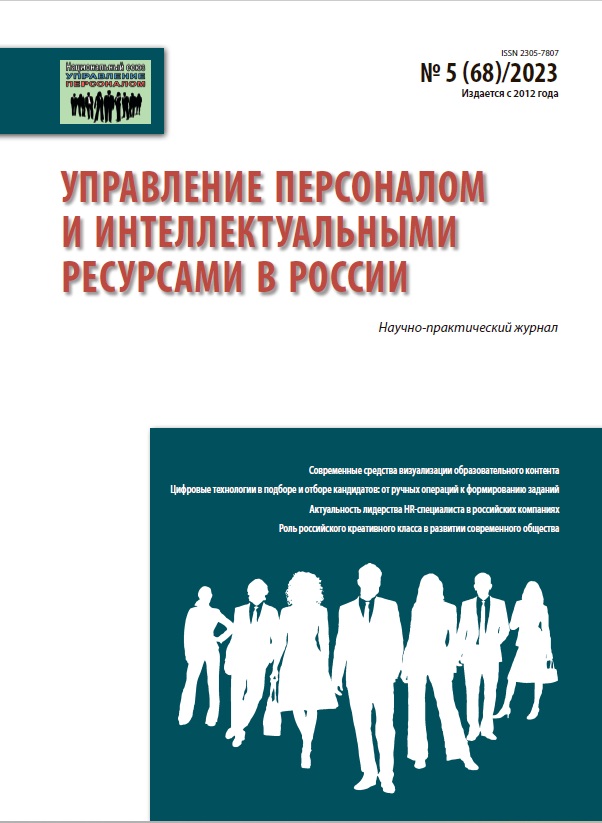The purpose of the study was to identify the predominant type of culture in the company, the image profile of the enterprise in the eyes of employees, the level and type of loyalty of personnel. The following research methods were applied in the work: a survey of the staff of a medical institution using the OCAI (Organizational Culture Analyze Instrument) methodology by Kim Cameron and Robert Quinn; a survey using the methodology of A. Ya. Kibanov to study the image profile of the employer; polling on the John Meyer and Natalie Allen organizational loyalty scale; Survey based on the methodology for assessing the level and parameters of the employee’s demonstrated loyalty to the organization. The analysis made it possible to determine what should be paid attention to when carrying out measures to improve and develop the image as an element of organizational culture. Attention was paid to strengthening and improving the organizational culture itself, increasing the loyalty of personnel, as well as improving the poorly developed qualities of the enterprise. The proposed recommendations can be used by the company’s management to strengthen its competitiveness and increase the loyalty of personnel.
image of the organization, image profile, organizational culture, organizational loyalty, employer, personnel management, human resources
1. Omelchenko N.V., Skripnichenko L.S. Formirovanie kommunikativnoj kompetentnosti personala // Upravlenie personalom i intellektual'nymi resursami v Rossii. 2021. T.10. №2. S. 40-45. (In Russian). DOI: https://doi.org/10.12737/2305-7807-2021-10-2-40-45; EDN: https://elibrary.ru/ONYTKE
2. Perederij V.A., Skripnichenko L.S. K voprosu o podderzhanii professional'nogo zdorov'ja personala v obrazovatel'nyh organizacijah // Upravlenie personalom i intellektual'nymi resursami v Rossii. 2021. T.10. №3. S.18-24. (In Russian). DOI: https://doi.org/10.12737/2305-7807-2021-10-3-18-24; EDN: https://elibrary.ru/VIOHAX
3. Rjabchevskaja E.S., Ershova M.V. Imidzh kak jelement jeffektivnogo upravlenija organizaciej// Nauchnye gorizonty. 2019. № 10 (26). S. 130-141. (In Russian). EDN: https://elibrary.ru/TXVWPC
4. Skorobogatov V.V. Kommunikacionnoe vzaimodejstvie institutov grazhdanskogo obshhestva i gosudarstvennoj vlasti v politiko-informacionnom prostranstve sovremennoj Rossii: dis… kand. politich. nauk. Krasnodar. 2010. S. 204. (In Russian).
5. Hagaeva A.V., Abueva H.L. Imidzh organizacii kak faktor povyshenija ee konkurentosposobnosti // FGU Science. 2019. № 1 (13). S. 118-123. (In Russian). EDN: https://elibrary.ru/ZCRYKD
6. Elliott R. H. et al. Strategic brand management. Oxford University Press, USA, 2019.
7. Lieven T. et al. The effect of brand design on brand gender perceptions and brand preference //European Journal of Marketing. 2018. T. 49. №. 1/2. P. 146-169.
8. Aakash G. Effectiveness of Online Recruitment and Selection Process: A Case of Tesco // Oxford Brookes University Journal. 2018. № 5 (34). P. 13-18.
9. Mazzarol, T., Soutar, G., & Limnios, E. M. Member loyalty and WOM in co-operative and mutual enterprises // Journal of Services Marketing. 2019. 33(3). P. 303-315.
10. Snawi A., Awang Z., Afthanorhan A., Mohamad M., Karim F. The influence of hospital image and service quality on patients’ satisfaction and loyalty // Management Science Letters. 2019. 9(6). P. 911-920.






